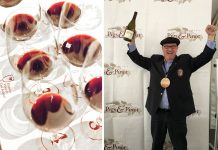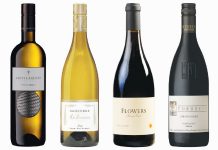Story by Charles Fredy
 People often ask about the difference between Old World and New World wines. The line has blurred somewhat, but knowing the difference can help you choose the right wine for the right occasion.
People often ask about the difference between Old World and New World wines. The line has blurred somewhat, but knowing the difference can help you choose the right wine for the right occasion.
As a general rule, Old World wines are meant to be enjoyed with food. New World wines are wonderful on their own, but need more careful consideration when you pair them with food.
One key is acid. Europe’s cooler climate creates a wine with a higher acid content, a firm acid structure that can be a challenge on the palate if drunk alone. Such wines marry well with food, especially when paired with cuisines from the same region. For example, Liguria, on the northern Italian coast, has many fishing villages. The wines grown there are light and fresh and perfect for seafood.
Most New World wines are grown in regions warmer than Europe. Vineyards here produce very ripe clusters of fruit with higher sugar content, lower acid. The result is wines that are lush, rich, more palatable to drink on their own. But such wines are harder to pair with food, especially cuisine that is spicy or complex. A big, rich, oaky California chardonnay can work well with lobster and butter, but throw in some lemongrass or Thai spice, and the wine is no longer harmonious.
Like acidity, oak plays a major role in a wine’s compatibility with food. In Europe, the use of oak is typically more restrained and integrated. It has a stronger influence in the bolder, fruitier wines of the New World.
As I mentioned earlier, the differences between Old World and New are becoming less defined. Some Old World producers have begun to employ modern winemaking techniques, creating nontraditional styles to compete with the wines of California, Australia and Argentina—wines that have a fresher, livelier taste. At the same time, we’re seeing a lot more New World wines with less oak, more integrated flavors, more balance.
I commend those who eagerly and passionately seek out something new (including something Old). In that vein, here are some New World vs. Old World challenges for you to try.
- Hartford Court, Four Hearts, Chardonnay, Russian River vs. J. Moreau, Chablis, Burgundy
- Spy Valley, Sauvignon Blanc, Marlborough vs. Domaine Jean Reverdy, Sancerre Blanc, Loire
- Treana Viognier, Central Coast vs. Domaine Coussergues, Viognier, Languedoc
- D’Arenberg, Laughing Magpie, Shiraz, McLaren Vale vs. Domaine Jaboulet, Croze-Hermitage, Rhone
- Flora Springs, Merlot, Napa Valley vs. Chateau Lassegue, St-Émilion, Bordeaux
- Carmel Road, Pinot Noir, Monterey vs. Louis Jadot, Pommard, Beaune





